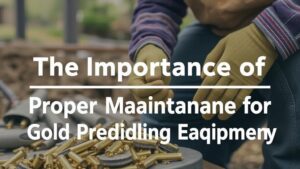Techniques for Reclaiming Precious Metals From Old Heap Leach Pads
Introduction
The reclamation of precious metals from old heap leach pads serves as a critical component in the sustainable practices of modern mining operations. Heap leaching, a method pioneered in the late 20th century, allows for the extraction of metals such as gold and silver from low-grade ore, leading to substantial economic benefits. As the mining industry transitions towards more environmentally responsible practices, reclaiming precious metals from expired leach pads has gained traction. This approach not only reduces waste but also recovers valuable resources, contributing to a circular economy.
Foundational Concepts and Equipment
Understanding the reclamation of precious metals requires familiarity with certain terms and the equipment involved in the process. Key concepts include:
- Heap Leach Pad: A system designed for the extraction of metals by applying a leaching solution over piled ore.
- Leaching Agent: Chemicals like cyanide or sulfuric acid that dissolve metals from ore.
- Adsorption: The process by which metals adhere to a solid surface, often utilizing activated carbon.
Essential equipment includes:
- Pump Systems: Used to circulate leach solutions through heaps to enhance recovery rates.
- Geochemical Analyzers: Instruments that detect various metal concentrations in leach solutions and residues.
- Separation Technologies: Methods such as flotation or gravity separation that assist in separating reclaimed metals from contaminants.
Step-by-Step Methodology
The following detailed methodology outlines the reclamation process from old heap leach pads:
- Site Assessment: Evaluate the pad’s age, prior processing methods, and current geological status using geophysical surveys and historical data.
- Leach Solution Application: Reactivate the leach pad by applying a leaching agent to maximize metal recovery, often concentrated to increase efficiency.
- Solution Collection: Use pump systems to collect resulting leach solutions, ensuring to monitor metal concentrations periodically.
- Metal Recovery: Apply adsorption methods or precipitation techniques to reclaim metals from the leach solutions.
- Post-Reclamation Monitoring: Conduct regular assessments to evaluate environmental impacts and adjust methods accordingly for future operations.
Advanced Techniques
For professionals looking to optimize the reclamation process, advanced techniques can significantly enhance efficiency:
- Heap Optimization: Adjusting heap height and compaction levels can improve the flow of leach solutions and metal recovery rates.
- Solution Chemistry Control: Frequent monitoring and adjustment of pH and ion concentrations in leach solutions can greatly affect recovery efficiency.
- Utilization of Bioleaching: Employing microorganisms to selectively extract metals offers an eco-friendly alternative to traditional methods.
It is essential for operators to maintain detailed records of test results to calibrate equipment and enhance consistency in recovery rates.
Legal, Ethical, and Safety Frameworks
The reclamation of precious metals is governed by a range of legal and ethical guidelines. Potential legal considerations include:
- Permitting: Operators must acquire permits from local and national authorities before initiating any reclamation strategy.
- Environmental Regulations: Compliance with environmental laws regarding land use and water quality is mandatory to prevent harmful impacts.
- Safety Protocols: Useing strict safety measures to protect workers from hazardous materials during reclamation tasks is essential.
Ethical considerations also come into play, as communities often expect transparency and fair practices concerning land management and resource recovery. Engaging with stakeholders and environmental organizations can foster trust and promote sustainable practices.
Practical Field Guidance and Resources
Identifying optimal sites for reclamation involves evaluating several criteria:
- Historical Data: Analyze historical data on previous outputs and recovery methods employed in the heap leach pad.
- Geographic and Geological Features: Assess land topography, ore type, and local hydrology to predict potential recovery success.
- Access to Infrastructure: Consider proximity to processing facilities and transportation networks for efficient ore movement.
Practical steps for implementation include acquiring necessary equipment and training staff on reclamation protocols. Utilizing available resources, such as industry workshops and webinars on sustainable practices, can further enhance knowledge and operational efficiency.



